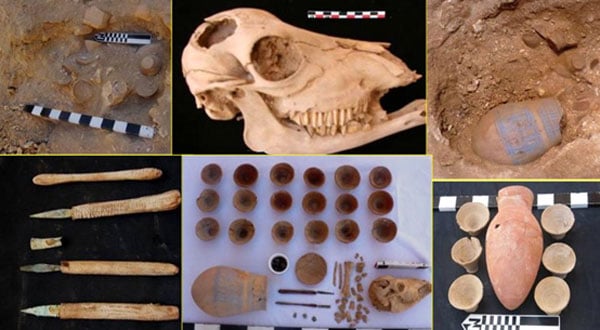Mysterious artifacts discovered buried in the Valley of the Kings
Archaeologists have discovered an unusual array of artifacts in four separate deposits in the Valley of the Kings, which they believe were buried as part of a ritual before the construction of a tomb, which has not yet been discovered.
The artifacts include the head of a cow, a vase painted in blue, and flint blades that have wooden handles, still preserved after more than three millennia. In the recent Current Research in Egyptology conference in London, the researchers refer to the artifacts as foundation deposits, which are ritual offerings placed in front of or around a tomb or temple to mark the commencement of its construction.
"Usually included are miniature versions of the tools used in the tomb or temple's construction, miniature offering vessels sometimes with offerings intact, and food offerings such as a calf's head and limbs," said Afifi Ghonim, archaeologist with the Egyptian Ministry of State for Antiquities. "Only a few foundation deposits have been found in the Valley of the Kings, and even fewer have been found intact."

The position of the four deposits found in the Valley of the Kings. Credit: Afifi Rohim Afifi and Glen Dash
Foundation deposits are usually laid out so that four of them form a box shape and a fifth is placed on the axis of the tomb. "We found the four deposits that made up the box, but not the fifth. Perhaps it too is there, awaiting discovery in front of the tomb," Ghonim said.
The researchers are also hoping to find the tomb itself, however, numerous attempts to date have not yielded any results. It is possible that the tomb may have been started but never completed.
"The foundation deposits could have been laid down before the site was abandoned. Work here may then have begun again during the reign of Tutankhamen or Ay [his successors], and at that time the foundation deposits, now forgotten, were covered over with an additional layer of fill to level the area for the construction of workmen's huts," said Ghonim.
Work is currently underway to date the foundation deposits, which could provide clues as to who the tomb was built for. Ghonim has suggested that one possibility is the tomb of Amenhotep IV, who later changed his name to Akhenaten.
Featured image: A cow's head, a blue painted vase, flint blades, ceramics and other artifacts from four deposits possibly buried as a ritual act. Credit: Afifi Rohim Afifi and Glen Dash
Location: Valley of the Kings, Egypt




















Comments
discoveries just give so much insight into past times